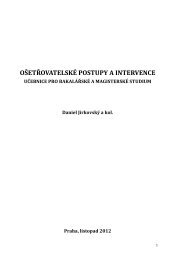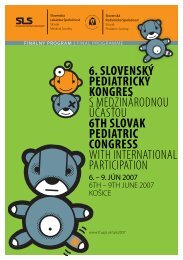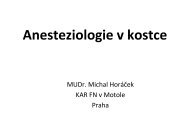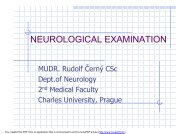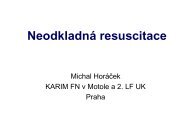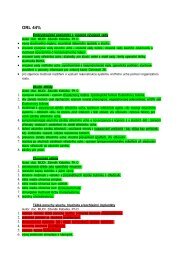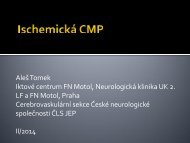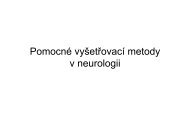Zde - 2. lékařská fakulta - Univerzita Karlova
Zde - 2. lékařská fakulta - Univerzita Karlova
Zde - 2. lékařská fakulta - Univerzita Karlova
Create successful ePaper yourself
Turn your PDF publications into a flip-book with our unique Google optimized e-Paper software.
P-61. ASTROCYTIC MORPHOLOGICAL AND FUNCTIONAL ALTERATIONS IN THEPREFRONTAL CORTEX DURING THE PROGRESSION OF ALZHEIMER’S DISEASE IN THE3XTG-AD ANIMAL MODELKulijewicz-Nawrot M. 1 , Syková E. 1,2 , Verkhratsky A. 1,3 , Rodríguez J. 1,4,51 Institute of Experimental Medicine, ASCR, Prague, Czech Republic; 2 Department of Neuroscienceand Center for Cell Therapy and Tissue Repair, Charles University, 2nd Medical Faculty, Prague,Czech Republic; 3 Faculty of Life Sciences, The University of Manchester, Manchester, UnitedKingdom; 4 IKERBASQUE, Basque Foundation for Science, Bilbao, Spain; 5 Department ofNeurosciences, University of the Basque Country, Leioa, Spain.Supervisor: Prof. MUDr. Eva Syková, DrSc.Introduction: Alzheimer’s disease (AD) is a progressive neurodegenerative disease, which stronglydeteriorates cognitive functions and memory controlled by the medial prefrontal cortex (mPFC) in strictcooperation with hippocampus and entorhinal cortex, both structures highly afflicted in AD. Astrocytesassure the internal functional equilibrium of the CNS, including the mPFC and play a key role inneuropathological processes, such as Alzheimer’s disease.Aims: Here, we analyzed astrocytic changes within the mPFC in AD by: measuring the surface andvolume of the cytoskeletal glial fibrillary acidic protein (GFAP), their relation with amyloid-β deposits(Aβ), as well as their glutamine synthetase (GS) and glutamate transporter (GLT-1) expression.Materials and Methods: We used quantitative confocal and light microscopy immunohistochemistryand Western blot analysis to compare transgenic (3xTG-AD) and non-transgenic animals at differentages (1 to 18 months).Results: Transgenic animals showed clear cytoskeleton GFAP atrophy, starting from early ages (3months; 37.93 and 48.30% decrease in surface and volume, respectively) and sustained throughoutthe disease progression at 9, 12 and 18 months (47.99% and 31.66%; 38.47% and 35.79%; 40.89%and 36.17%, respectively). This atrophy is independent of Aβ accumulation, since only a few GFAPpositivecells were present in close vicinity of Aβ aggregates, suggesting no direct relationshipbetween astrocytic atrophy and Aβ toxicity. We also observed a decrease in GS-positive astrocytes at1, 3, 6 and 9 months (17.38%, 11.74%, 27.21% and 27.52%, respectively) together with a reduced GSexpression from 3 to 12 months of age. Interestingly, we did not observe significant changes in GLT-1expression, despite a clear tendency to decline.Conclusions: Our results indicate that the concomitant reduction in astrocytic branching and GSexpression in the mPFC can lead to early manifested homeostatic dysfunctions, including synapticmalfunction, and result in the serious cognitive deficits observed in AD.Support: GACR 304/11/0184, P304/12/G069, PITN-GA-2008-21400393



